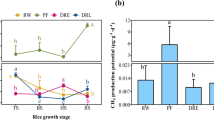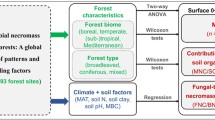Abstract
Arctic terrestrial ecosystems are strongly dominated by temperature, and global warming is expected to have a particularly strong impact in high latitudes. The Arctic will therefore be an important region for early detection of global change. In the present study the effects of environmental manipulations simulating climate change on soil microorganisms and nematode populations were investigated. Study sites were a dwarf shrub dominated tree-line heath (450 m a.s.l.) and a high altitude fellfield (1150 m a.s.l.) at Abisko, Swedish Lapland. Soil temperature was enhanced by using passive greenhouses and the impact on soil organisms with and without NPK fertilizer addition was assessed. The nematode community was strongly affected by warming and nutrient application. Population density was twice as high for all treatments at the fellfield as compared to controls. At the heath temperature enhancement with or without fertilizer application also led to a doubling of the population density, whereas fertilization alone caused an increase of about one third. The environmental manipulations resulted in a greater microbial biomass C and active fungal biomass in the heath soil. Increased density was also recorded for bacterial and fungal feeding nematodes at both sites. The results suggest that nematodes have an important impact on microbial biomass and turnover rates in the two subarctic systems. Elevated soil temperature apparently will lead to increased grazing on microorganisms, contributing to enhanced net N and P mineralization rates and plant nutrient availability. However, biodiversity was generally affected negatively by the environmental manipulations. The effects were more severe at the high altitude fellfield indicating that the influence of elevated temperature will be more pronounced in systems already stressed by extreme climatic conditions.
Similar content being viewed by others
References
Aescht E and Foissner W 1992 Effects of mineral and organic fertilizers on the microfauna in a high-altitude reafforestation trial. Biol. Fertil. Soils 13, 17-24.
Ambrose W R 1980 Monitoring long-term temperature and humidity. ICCM Bulletin 6, 36-42.
Anderson R V and Coleman D C 1982 Nematode temperature responses: a niche dimension in populations of bacterial-feeding nematodes. J. Nematol. 14, 69-76.
Beare M H, Parmelee R W, Hendrix P F, Coleman D C and Crossley D A Jr 1992 Microbial and faunal interactions and effects on litter nitrogen and decomposition in agroecosystems Ecol. Monogr.62, 569-591.
Bernard E C 1992 Soil nematode biodiversity. Biol. Fertil. Soils 14, 99-103.
Bloemers G F, Hodda M, Lambshead P J D, Lawton J H and Wanless F R 1997 The effects of forest disturbance on diversity of tropical soil nematodes. Oecologia 111, 575-582.
Boag B, Crawford J W and Neilson R 1991 The effect of potential climatic changes on the geographical distribution of the plant-parasitic nematodes Xiphinema and Longidorus in Europe. Nematologica 37, 312-323.
Bongers T 1990 The maturity index: an ecological measure of environmental disturbance based on nematode species composition. Oecologia 83, 14-19.
Bowman W D 1994 Accumulation and use of nitrogen and phosphorus following fertilization in two alpine tundra communities. Oikos 70, 261-270.
Briones M J I, Ineson P and Piearce T G 1997 Effects of climate change on soil fauna; responses of enchytraeids, Diptera larvae and tardigrades in a transplant experiment. Appl. Soil Ecol. 6, 117-134.
Callaghan T V, Sonesson M and Sømme L 1992 Responses of terrestrial plants and invertebrates to environmental change at high latitudes. Phil. Trans. R. Soc. London B 338, 279-288.
Christensen T R, Michelsen A, Jonasson S and Schmidt I K 1997 Carbon dioxide and methane exchange of a subarctic heath in response to climate change related environmental manipulations. Oikos 79, 34-44.
Coulson S J, Hodkinson I D, Webb N R, Block W, Bale J S, Strathdee A T, Worland M R and Wooley C 1996 Effects of experimental temperature elevation on high-arctic soil microarthropod populations. Polar Biol. 16, 147-153.
Freckman D W and Ettema C H 1993 Assessing nematode communities in agroecosystems of varying human intervention. Agricul. Ecosys. Environ. 45, 239-261.
Freckman D W and Virginia R A 1997 Low-diversity antarctic soil nematode communities: distribution and response to disturbance. Ecology 78, 363-369.
Graglia E, Jonasson S, Michelsen A and Schmidt I K 1997 Effects of shading, nutrient application and warming on leaf growth and shoot densities of dwarf shrubs in two arctic-alpine plant communities. Ecoscience 4, 191-198.
Grant W D and West A W 1986 Measurement of ergosterol, diaminopimelic acid and glucosamine in soil: evaluation as indicators of microbial biomass. J. Microbiol. Meth. 6, 47-53.
Griffiths B S 1989 The role of bacterial feeding nematodes and protozoa in rhizosphere nutrient cycling. Aspects Appl. Biol. 22, 141-145.
HánLel L 1996 Soil nematodes in five spruce forests of the Beskydy mountains, Czech Republic. Fundam. appl. Nematol. 19, 15-24.
Harte J, Rawa A and Price V 1996 Effects of manipulated soil microclimate on mesofaunal biomass and diversity. Soil Biol. Biochem. 28, 313-322.
Havström M, Callaghan T V and Jonasson S 1993 Differential growth responses of Cassiope tetragona, an arctic dwarf-shrub, to environmental perturbations among three contrasting highand subarctic sites. Oikos 66, 389-402.
Heal O W 1997 Response of arctic soils to environmental change: biodiversity, system processes and functions. In Functional implications of biodiversity in soil. Ed. V Wolters. pp 103-118. Ecosystems research report 24, European Communities, Belgium.
Hobbie S E 1996 Temperature and plant species control over litter decomposition in Alaskan tundra. Ecol. Mon. 66, 503-522.
Hodkinson I D, Coulson S J, Webb N R and Block W 1996 Can high Arctic soil microarthropods survive elevated summer temperatures? Funct. Ecol. 10, 314-321.
Huhta V, Hyvönen R, Koskenniemi A, Vilkamaa P, Kaasalainen P and Sulander M 1986 Response of soil fauna to fertilization and manipulation of pH in coniferous forests. Acta Forest. Fenn. 195, 1-30.
Ingham R E, Trofymow J A, Ingham E R and Coleman D C 1985 Interactions of bacteria, fungi, and their nematode grazers: effects on nutrient cycling and plant growth. Ecol. Mon. 55, 119-140.
Jonasson S, Havström M, Jensen M and Callaghan T V 1993 In situ mineralization of nitrogen and phosphorus of arctic soils after perturbations simulating climate change. Oecologia 95, 179-186.
Jonasson S, Michelsen A, Schmidt I K, Nielsen E V and Callaghan T V 1996 Microbial biomass C, N and P in two arctic soils and their responses to addition of NPK fertilizer and sugar: Implications for plant nutrient uptake. Oecologia 106, 507-515.
Jonasson S, Michelsen A and Schmidt I K Responses in microbes and plants to changed temperature, nutrient and light regimes in the Arctic. Ecology. (In press).
Kennedy A D 1994 Simulated climate change: a field manipulation study of polar microarthropod community response to global warming. Ecography 17, 131-140.
Meyer E and Thaler K 1995 Animal diversity at high altitudes in the Austrian Central Alps. In Arctic and alpine biodiversity. Eds F S Chapin III and C Körner. pp 97-108. Springer Verlag, Berlin, Germany.
Michelsen A, Jonasson S, Sleep D, Havström M and Callaghan T V 1996 Shoot biomass, δ13C, nitrogen and chlorophyll responses of two arctic dwarf shrubs to in situ shading, nutrient application and warming simulating climatic change. Oecologia 105, 1-12.
Nadelhoffer K J, Giblin A E, Shaver G R and Linkins A E 1992 Microbial processes and plant nutrient availability in arctic soils. In Arctic ecosystems in a changing climate: an ecophysiological Perspective. Eds F S Chapin III, R L Jefferies, J F Reynolds, G R Shaver and J Svoboda. pp 281-300. Academic Press, San Diego, USA.
Paal J, Fremstad E and Möls T 1997 Responses of the Norwegian alpine Betula nana community to nitrogen fertilization. Canad. J. Bot. 75, 108-120.
Parsons A N, Welker J M, Wookey P A, Press M C, Callaghan T V and Lee J A 1994 Growth responses of four sub-arctic dwarf shrubs to simulated environmental change. J. Ecol. 82, 307-318.
Pielou E C 1974 An introduction to mathematical ecology. Wiley & Sons, New York, USA.
Procter D L C 1983 Form of the individual growth curve and developmental rate of the High Arctic nematode Chiloplacus sp. Growth 47, 174-183.
Procter D L C 1984a Population growth and intrinsic rate of natural increase of the high arctic nematode Chiloplacus sp. at low and high temperatures. Oecologia 62, 138-140.
Procter D L C 1984b Towards a biogeography of free-living soil nematodes. I. Changing species richness, diversity and densities with changing latitude. J. Biogeogr. 11, 103-117.
Procter D L C 1990 Global overview of the functional roles of soilliving nematodes in terrestrial communities and ecosystems. J. Nematol. 22, 1-7.
Ruess L 1995a Studies on the nematode fauna of an acid forest soil: spatial distribution and extraction. Nematologica 41, 229-239.
Ruess L 1995b Nematode fauna in spruce forest soils: a qualitative/ quantitative comparison. Nematologica 41, 106-124.
Ruess L 1998 Nematode fauna of a subarctic dwarf shrub heath at Abisko, northern Swedish Lapland. In Nematode communities of northern temperate grassland ecosystems. Eds R G M de Goede and T Bongers. pp 261-264. Focus, Giessen, Germany.
Ruess L, Michelsen A, Schmidt I K, Jonasson S and Dighton J 1998 Soil nematode fauna of a subarctic heath: potential nematicidal action of plant leaf extracts. Appl. Soil Ecol. 7, 111-124.
Ruess L, Michelsen A and Jonasson S Simulated climate change in subarctic soils: responses in nematode species composition and dominance structure. Nematology: Int. J. Fund. Appl. Nematology. (Submitted).
Schmidt I K, Jonasson S and Michelsen A 1999 Mineralization and microbial immobilization of N and P in arctic soils in relation to season, temperature and nutrient amendment. Appl. Soil Ecol. 11, 147-160.
Shaver G R and Chapin F S III 1986 Effect of fertilizer on production and biomass of tussock tundra, Alaska, U.S.A. Arctic Alpine Res. 18, 261-268.
Shaver G R and Chapin F S III 1991 Production: biomass relationships and element cycling in contrasting arctic vegetation types. Ecol. Monogr. 61, 1-31.
Shaver G R and Chapin F S III 1995 Long-term responses to factorial, NPK fertilizer treatment by Alaskan wet and moist tundra sedge species. Ecography 18, 259-275.
Smith M J and Walton D W H 1985 A statistical analysis of the relationships among viable microbial populations, vegetation, and environment in a subantarctic tundra. Microb. Ecol. 11, 245-257.
Sohlenius B 1985 Influence of climatic conditions on nematode coexistence: a laboratory experiment with a coniferous forest soil. Oikos 44, 430-438.
Sohlenius B 1996 Structure and composition of the nematode fauna in pine forest soil under the influence of clear-cutting. Effects of slash removal and field layer vegetation. Eur. J. Soil Biol. 32, 1-14.
Sohlenius B, Boström S and Ekebom A 1997 Metazoan microfauna in an ombrotrophic mire at Abisko, northern Sweden. Eur. J. Soil Biol. 33, 31-39.
Sulkava P, Huhta V and Laakso J 1996 Impact of soil faunal structure on decomposition and N-mineralisation in relation to temperature and moisture in forest soil. Pedobiologia 40, 505-513.
Trudgill D L and Perry J N 1994 Thermal time and ecological strategies - a unifying hypothesis. Ann. Appl. Biol. 125, 521-532.
Verhoef H A and Brussaard L 1990 Decomposition and nitrogen mineralisation in natural and agroecosystems: The contribution of soil animals. Biogeochem. 11, 175-211.
Wasilewska L 1995 Directions of changes in communities of soil nematodes in man-disturbed ecosystems. Acta Zool. Fenn. 196, 271-274.
Yeates G W, Bongers T, Goede de R G M, Freckman D W and Georgieva S S 1993 Feeding habits in soil nematode families and genera-an outline for soil ecologists. J. Nematol. 25, 315-331.
Yeates G W and Bird A F 1994 Some observations on the influence of agricultural practices on the nematode faunae of some South Australian soils. Fundam. appl. Nematol. 17, 133-145.
Yeates G W, Bardgett R D, Cook R, Hobbs P J, Bowling P J and Potter J F 1997 Faunal and microbial diversity in three Welsh grassland soils under conventional and organic management regimes. J. Appl. Ecol. 34, 453-470.
Author information
Authors and Affiliations
Rights and permissions
About this article
Cite this article
Ruess, L., Michelsen, A., Schmidt, I.K. et al. Simulated climate change affecting microorganisms, nematode density and biodiversity in subarctic soils. Plant and Soil 212, 63–73 (1999). https://doi.org/10.1023/A:1004567816355
Issue Date:
DOI: https://doi.org/10.1023/A:1004567816355




